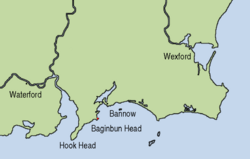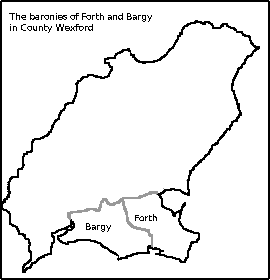Siege of Wexford (1169) facts for kids
Quick facts for kids Siege of Wexford (1169) |
|||||||||
|---|---|---|---|---|---|---|---|---|---|
| Part of the Anglo-Norman invasion of Ireland | |||||||||
 |
|||||||||
|
|||||||||
| Belligerents | |||||||||
| Norse-Gaels of Wexford | Anglo-Normans Cambro-Normans |
||||||||
| Commanders and leaders | |||||||||
| unknown | Robert FitzStephen Diarmait Mac Murchada |
||||||||
| Strength | |||||||||
| ~2,000 |
900-1000 Including: 500 Irish allies |
||||||||
| Casualties and losses | |||||||||
| 3 killed, several ships destroyed | 18 killed | ||||||||
The Siege of Wexford happened in May 1169. It was the first big fight of the Anglo-Norman invasion of Ireland. The town of Wexford was attacked by a group of Normans led by Robert Fitz-Stephen. They were joined by soldiers loyal to Diarmait mac Murchadha.
Diarmait had been removed as the King of Leinster. He asked the Normans for help to get his kingdom back. He also wanted to control Wexford, which was a busy port city. Even though the attackers could not break through the town's walls, Wexford gave up after almost two days. The town then came under Norman control.
Why the Siege Happened
In 1167, Diarmait Mac Murchada was the King of Leinster. But he was removed from power and sent away from Ireland. This happened because of the High King of Ireland, Ruaidrí Ua Conchobair, and his friend Tigernán Ua Ruairc.
Diarmait really wanted his kingdom back. He even hoped to become the High King himself. So, he went to France and asked for military help. He met with Henry II, the King of England. King Henry allowed Diarmait to find help from Norman lords in his kingdom.
Some powerful Norman lords agreed to help. These included Richard de Clare, also known as "Strongbow." Also, half-brothers Robert Fitz-Stephen and Maurice FitzGerald joined. Robert Fitz-Stephen brought his half-nephew Robert de Barry with him.
Diarmait made big promises to get their help. Strongbow was promised Diarmait's daughter, Aoife, in marriage. He was also promised the kingship of Leinster after Diarmait died. Robert and Maurice were promised land in Wexford and other places for their support.
Around May 1, 1169, Robert Fitz-Stephen landed in Ireland. He brought 30 knights, 60 armed men, and 300 bowmen. The next day, Maurice de Prendergast arrived with ten knights and 60 bowmen. This group joined about 500 soldiers from Diarmait's army. Together, they marched towards Wexford.
First Fight at Duncormick
On their way to Wexford, the army met some Irish fighters at Duncormick. There was a short fight, and the army managed to cross the river. They then kept moving northeast towards Wexford. We don't know how many people were hurt in this fight.
Some historians say this small fight is very important. It was the first time anyone tried to stop the Normans. It was the first bloody battle in a long struggle that lasted for many years.
The Attack on Wexford
Wexford heard that the army was coming. The town's defenders first planned to fight outside the walls. But when they saw how strong the attacking army was, they changed their minds. They burned their outer buildings so the attackers would have no cover. Then, they went inside the town walls to defend it. It is believed that about 2,000 defenders were inside Wexford.
The Normans launched their first attack on Wexford. But the defenders fought them off. During this attack, 18 Normans and 3 defenders were killed. These are thought to be the only deaths during the entire siege. After this, Fitz-Stephen ordered his men to burn all the ships in Wexford's harbor.
The next morning, the attack on Wexford started again. Soon after, the defenders sent messengers to Diarmait. The people of Wexford agreed to give up and promised to be loyal to Diarmait again. It is said that two bishops who were in the town helped convince them to surrender.
What Happened Next
After the siege, the attacking army and its leaders stayed at Ferns. This was Diarmait's main base. Robert Fitz-Stephen was given control of Wexford. He also received a large area of land. This land is now known as the baronies of Forth and Bargy. This area became the first Norman settlement in Ireland.
After about three weeks, Diarmait and Fitz-Stephen's forces attacked the land of Osraighe. This area was on Leinster's western border. They also raided areas to the north.
High King Ruaidhrí Ua Conchobhair brought his army into Leinster. With help from the Church, the leaders of both armies began talking. They made an agreement. Diarmait was allowed to remain King of Leinster. But he had to recognize Ruaidhrí as the High King. He also had to agree to send his Norman allies back to Britain.
Even though there was peace for a short time, Diarmait allowed the Normans to stay in Leinster. In May 1170, more Normans arrived. This started the invasion again.


